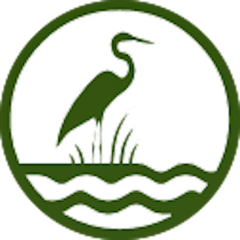Herons are Cool!

Herons & Egrets
by Emma Reid
Egrets and herons are birds that are obviously designed to wade about in water. Different species have different length legs, allowing each to search for food in different depths of water. Several also have peculiar behaviors associated with food gathering.
The terms heron and egret are common names and are not meant to suggest that herons are different from egrets; they all belong to the family Ardeidae. They all have straight, pointed beaks of varying lengths. When they fly, they constantly flap their wings in long, deep strokes, and they retract their necks toward the body in a S-shaped fashion. Ibises and spoonbills belong to the family Threskiornithidae. All ibises have down-curved beaks (the Cajuns call them Bec Croche, curved beak); the one spoonbill we have has a straight beak that has a rounded disk on the tip. All of these birds flap their wings rapidly and shallowly, often gliding between flapping episodes; they fly with their necks outstretched.
The following is a discussion of the common forms found in the New Orleans area.
Great Blue Heron – This is our largest local bird, and one can’t help but think of prehistoric pterodactyl when they make their characteristic squawk and launch into the air. This is truly a beautiful bird, with striking color patterns.
Louisiana (Tricolored) Heron – Tricolored Heron is the proper name, but I believe we should continue to call them Louisiana Herons. This is one of the most beautiful herons in North America. It is easily recognized by its dark wings and back (mixture of burgundy and bluish gray) and white belly. The beak is especially long.
Little Blue Heron – Immature birds are white, but with a bluish bill that is very dark at the tip and greenish legs. Adults are grayish blue with a maroonish-brown neck. The bill is bluish with a dark tip and the legs are dark. Maturing birds transitioning from white to blue are pied with white and deep blue and are often called “calico herons.”
Green-backed Heron – These very small herons are green on the back with a chestnut neck. Legs are short and yellowish. This heron actually “fishes” for its food. It will creep out on a log or limb over water with its neck retracted, ready to dart forward to catch its prey. The birds will float a piece of grass or a leaf to serve as bait to attract fish within reach.
Yellow-crowned Night Heron – Gray bodied birds with a red eye, dark heads and bill, and a whitish cheek patch and crown. Mostly see feeding at night. Stand around with the neck retracted. Juveniles are brown with white spots. Can be heard flying overhead at night and calling “Quark.” Cajuns call these birds Gros Bec (big beak).
Black-crowned Night Heron – Overall body form like the species above, but with a black back and black crown. Juveniles very much the same, but the spots are larger. These are also called Gros Bec.
Common Egret – Our largest “white canal bird” (so called because so many large white birds hang out around local canals). This species is easily recognized by having dark legs and feet and a long yellow bill. When feeding, they often hold the neck extended, and lean forward as they move.
Snowy Egret – This bird is much smaller than the Common Egret, and is very easily recognized by having yellow feet on the ends of dark legs (looks like yellow shoes) and with feathers often curling up off the back of the head. The beak is entirely dark.
Reddish Egret – A generally uncommon egret, more common along the coast. Though there is a white phase (with bluish legs), the norm is a gray body with a rusty head and neck. The feathers are loosely arranged and look shaggy. The beak is flesh-colored with a dark tip. When it feeds, it holds the wings out and dances about, stirring up the fish, the stops suddenly and holds the wings out. The fish then run into the shade of the wings and the bird feeds.
Cattle Egret – A small white egret that has buffy brown markings on the back and chest during breeding season. Bill is short and yellow, and the legs are yellow to dusky green. Normally seen in fields feeding on insects that are stirred up by cattle, tractors, etc.
Glossy Ibis – A very dark, shiny iridescent bird that has a brown eye and the bare skin on the face is dark gray or brown. Very difficult to separate from the White-faced Ibis. For all ibis species, the young are a delicacy (and illegal).
White-faced Ibis – Looks like the above, but the eye is red and the bare skin on the face is reddish-brown.
White Ibis – This is the most easily distinguished local ibis. As adults, they are white with black tips on the wings. The juveniles are light brown with a wedge-shaped white rump patch that is obvious in flight.
Roseate Spoonbill – No local bird can be confused with this species. It is pink in color, and may be whitish with some pink to its pattern. The obvious terminal disk on the beak is also difficult to miss. Many locals think these are flamingos. They are common in southwest Louisiana, but often seen in Barataria-Terrebonne and adjacent areas.
